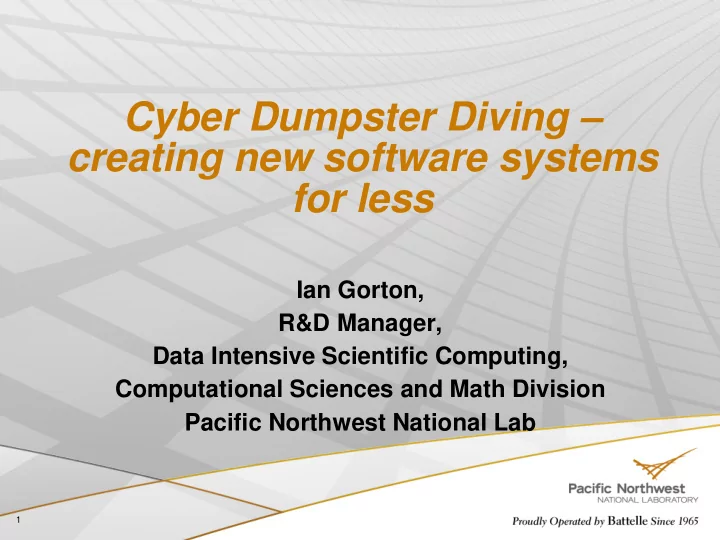

Cyber Dumpster Diving – creating new software systems for less Ian Gorton, R&D Manager, Data Intensive Scientific Computing, Computational Sciences and Math Division Pacific Northwest National Lab 1
Pacific Northwest National Lab Department of Energy Science Lab Fundamental sciences National security 4500+ people Business volume of over $1b per annum Large scale experimental facilities, e.g. Environmental Molecular Sciences Lab (EMSL) 161 Tflop supercomputer 2
DISC@PNNL Data Intensive Scientific Computing High Performance User platforms Computing Data management Tool integration DISC Workflows Provenance Scientific Applications in e.g. User Bioinformatics Environments Climate modeling Carbon sequestration Subsurface modeling 3
The middle is a hard place … Requirements Need to understand science domain Need to understand HPC Difficult to define, constant refinement, negotiations, communications “The hardest single part of building a software system is deciding precisely what to build.” Design Conflicting quality requirements Complex, heterogeneous technologies Large data Proliferation of tools, variable quality 4
Project Funding Profiles Typically fixed amounts What can we build with X dollars? Fixed amounts per year, 1-3 year lifecycle Limited funding From .25 to 10 team size per year 1-2 people per year most common High expectations Scientists think ‘software is easy’ it’s just coding, right? 5
The most radical possible solution for constructing software is not to construct it at all. Fred Brooks: No Silver Bullet: Essence and Accidents of Software Engineering 6
7
Carbon Sequestration (Storage) 8
Geological Sequestration Software Suite (GS3) Large-scale, complex data Experimental HPC Simulation inputs/outputs Multiple realizations for uncertainty quantification Long-lived projects Modeling Analysis Monitoring (100+ years) 9
A powerful, usually legal, source of information that isn't seriously defended because of social taboos. 10
‘Write-as-little-code-as-possible’ Reuse Approach: Leverage open source frameworks and tools Extend to support science applications Generalize to support multiple science domains Requires: Careful technology selection Creative design Robust architectures 11
Velo – Knowledge Management for Modeling and Simulation 12
Supporting Carbon Sequestration Modeling Requirements Collaboration Sharing data Metadata management User-driven customization Extensibility Model and data versioning Provenance and user annotation Robust, scalable Small project, team ~1.75 people, 3 years 13
Cyber Dumpster Diving Process ;) Open source Candidate technology assessments: Quality of docs Release schedule Community scope APIs Code/architecture Install and workout, simple tests 14
Feature-Reuse Matrix Feature Solution Notes Reuse Collaboration Mediawiki Core wiki features support this 100% Sharing data Mediawiki Requires integration of MW and 60% Alfresco Alfresco Requires customization of MW and Metadata Mediawiki 80% Alfresco basic features management Alfresco User-driven Mediawiki Core wiki features support this 100% customization Extensibility Mediawiki APIs support extension, but requires 20% design of exact integration Alfresco mechanisms Model versioning Mediawiki Minor extensions for MW/Alfresco 75% capabilities Alfresco Some for free in MW, but advanced Provenance Mediawiki 20% features need developing Role-based Halo ACL Mediawiki extension 100% Security 15
GS3 Examples - Semantic Capabilities - Metadata Extraction Metadata: Generic information e.g.file size, owner, preview/thumbnails Specific to the file type, e.g. keywords, geographic location Metadata is searchable Extensible architecture for custom data types ingest pipelines, e.g. Simulation outputs Spreadsheets Input files 16
GS3 Examples - Tool Integration Mediawiki plugins ‘Black box’ tools External 3 rd party tools 17
GS3 Examples – Tool Plugins
GS3 Examples – Black box Tool Plugins
What Happened? Iterative development process Design, build and demo, repeat Interest from user community was strong Power of mock-ups and prototypes New funding obtained Initial sites deployed And along the way …
Velo - Flexible, Rigorous Scientific Knowledge Management GS3 ASCEM User customizable ‘skins’ Web-based SimSeQ FutureGen Extensible Raw data and metadata storage Versioning Velo Tools Provenance Tool registry Many deployment options Simulators Extensible data types Site Model Data Visualization Extensible tool repository Data Plume Calcs Programming interfaces 21
Velo Architecture External Tools (3D Visualization, Job Execution, Rich GUI) Tool Integration Semantic Wiki Convert Markup Store MediaWiki Data Ingest Core CMS Pipeline Wiki Integration Velo Knowledge Base Wiki Database CMS Velo synchronization process Core Semantic (Simulations, Models, Projects) Database Database 22
Some reflections Science is a complex domain Requirements, funding models Diversity of software/data Users who are pushing the boundaries Scientists don’t (in general) understand complexity of software systems Architectures, integration, testing Different to implementing a set of equations Through deliberate, creative reuse and a strong focus on architecture, we’ve: Built generically useful technologies at low cost) They work ;) 23
Questions? 24
Recommend
More recommend